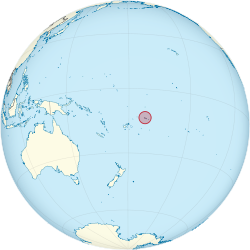Independent State of Samoa Malo Saʻoloto Tutoʻatasi o Sāmoa | |
|---|---|
| Motto: Faʻavae i le Atua Sāmoa "Samoa is founded on God" | |
| Anthem: O Le Fuʻa o le Saʻolotoga o Sāmoa "The Banner of Freedom" | |
 Location of Samoa | |
 Map of Samoa | |
| Capital and largest city | Apia 13°50′00″S 171°45′44″W / 13.83333°S 171.76222°W |
| Official languages | Samoan, English |
| Ethnic groups (2021) |
|
| Religion (2021) |
|
| Demonym(s) | Samoan |
| Government | Unitary parliamentary republic |
| Tuimalealiʻifano Vaʻaletoʻa Sualauvi II | |
| Fiamē Naomi Mataʻafa | |
| Papaliʻi Liʻo Taeu Masipau | |
| Legislature | Legislative Assembly |
| Independence from New Zealand | |
| 14 June 1889 | |
| 16 February 1900 | |
| 1 March 1900 | |
| 30 August 1914 | |
• League mandate | 17 December 1920 |
• UN trusteeship | 13 December 1946 |
• Western Samoa Act 1961 | 1 January 1962 |
| 15 December 1976 | |
• Name change from Western Samoa to Samoa | 4 July 1997 |
| Area | |
• Total | 2,831[4] km2 (1,093 sq mi) (167th) |
• Water (%) | 0.3 |
| Population | |
• November 2021 census | 205,557[3] (176th) |
• Density | 70/km2 (181.3/sq mi) |
| GDP (PPP) | 2024 estimate |
• Total | |
• Per capita | $5,962[5] |
| GDP (nominal) | 2024 estimate |
• Total | |
• Per capita | $4,420[5] |
| Gini (2013) | medium inequality |
| HDI (2022) | high (116th) |
| Currency | Tālā (WS$[b]) (WST) |
| Time zone | UTC+13[c] (WST) |
| Date format | dd/mm/yyyy |
| Drives on | left[d] |
| Calling code | +685 |
| ISO 3166 code | WS |
| Internet TLD | .ws |
| |
Samoa,[note 1] officially the Independent State of Samoa[note 2] and known until 1997 as Western Samoa (Samoan: Sāmoa i Sisifo), is an island country in Polynesia, consisting of two main islands (Savai'i and Upolu); two smaller, inhabited islands (Manono and Apolima); and several smaller, uninhabited islands, including the Aleipata Islands (Nuʻutele, Nuʻulua, Fanuatapu and Namua). Samoa is located 64 km (40 mi) west of American Samoa, 889 km (552 mi) northeast of Tonga, 1,152 km (716 mi) northeast of Fiji, 483 km (300 mi) east of Wallis and Futuna, 1,151 km (715 mi) southeast of Tuvalu, 519 km (322 mi) south of Tokelau, 4,190 km (2,600 mi) southwest of Hawaii, and 610 km (380 mi) northwest of Niue. The capital and largest city is Apia. The Lapita people discovered and settled the Samoan Islands around 3,500 years ago. They developed a Samoan language and Samoan cultural identity.
Samoa is a unitary parliamentary democracy with 11 administrative divisions. It is a sovereign state and a member of the Commonwealth of Nations. Western Samoa was admitted to the United Nations on 15 December 1976.[14] Because of the Samoans' seafaring skills, pre-20th-century European explorers referred to the entire island group, including American Samoa, as the "Navigator Islands".[15][16] The country was a colony of the German Empire from 1899 to 1915, then came under a joint British and New Zealand colonial administration until 1 January 1962, when it became independent.
- ^ "Samoa". CIA – The World Factbook. 26 October 2021. Archived from the original on 28 October 2021. Retrieved 24 January 2021.
- ^ Cite error: The named reference
Religionwas invoked but never defined (see the help page). - ^ a b "Samoa Population and Housing Census 2021" (PDF). Archived from the original on 3 April 2019. Retrieved 10 January 2023.
- ^ "Samoa". Central Intelligence Agency. 27 February 2023. Archived from the original on 28 October 2021. Retrieved 24 January 2021 – via CIA.gov.
- ^ a b c d "Samoa". International Monetary Fund. Archived from the original on 10 October 2018. Retrieved 10 October 2018.
- ^ "Gini Index coefficient". CIA World Factbook. Archived from the original on 17 July 2021. Retrieved 16 July 2021.
- ^ "Human Development Report 2023/2024" (PDF). United Nations Development Programme. 13 March 2024. Archived (PDF) from the original on 13 March 2024. Retrieved 13 March 2024.
- ^ "Samoa skips Friday in time zone change". ABC Australia. 31 December 2011. Archived from the original on 3 January 2012. Retrieved 16 January 2012.
- ^ Chang, Richard S. (8 September 2009). "In Samoa, Drivers Switch to Left Side of the Road". The New York Times. Archived from the original on 9 July 2017. Retrieved 23 May 2010.
- ^ Whitley, David (29 January 2016). "The 22 places you're probably pronouncing incorrectly". Stuff. Archived from the original on 8 February 2022. Retrieved 8 February 2022.
- ^ Deverson, Tony; Kennedy, Graeme, eds. (2005). "Samoa". The New Zealand Oxford Dictionary. Oxford University Press. doi:10.1093/acref/9780195584516.001.0001. ISBN 978-0-19-558451-6. Archived from the original on 28 February 2022. Retrieved 8 February 2022.
- ^ Upton, Clive; Kretzschmar, William A. Jr. (2017). The Routledge Dictionary of Pronunciation for Current English (2nd ed.). Routledge. p. 1179. ISBN 978-1-138-12566-7.
- ^ "Definition of 'Samoa'". Collins. Archived from the original on 31 August 2019. Retrieved 19 March 2022.
- ^ "List of Member States: S". United Nations. Archived from the original on 24 October 2007. Retrieved 27 November 2007.
- ^ "The Navigator Islands". The Argus. 2 January 1882. Archived from the original on 12 January 2022. Retrieved 1 May 2017.
- ^ "Samoa". Polynesian Culture Center. Archived from the original on 24 July 2011.
Cite error: There are <ref group=note> tags on this page, but the references will not show without a {{reflist|group=note}} template (see the help page).

